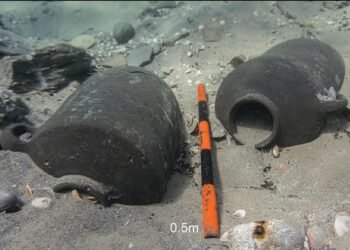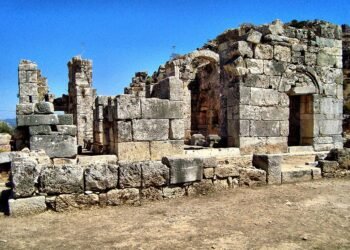Archaeologists excavating the historic Visegrád Citadel in Hungary have uncovered an extraordinary cache of artifacts that feature evidence of the intense sieges and military history of the region during the 16th and 17th centuries. Situated atop a hill overlooking the Danube River in Pest County, the 13th-century fortress, once a royal residence, is currently undergoing a large-scale restoration project aimed at preserving its cultural heritage.
The recent discoveries were made during excavations of a filled-in moat that dates back to the Angevin period. According to Hungary’s National Archaeological Institute, the finds include a diverse range of weaponry such as small arms, cannonballs, arrowheads, and melee weapons. Evidence of fierce battles is evident from the heavy battle damage found on many of these items.
One of the most remarkable discoveries is a fragmented cabasset helmet, a conical infantry helmet widely used across Europe between 1550 and 1700. Decorated with copper rosettes and featuring an ornate copper feather swivel at the back, this helmet is believed to have belonged to a Habsburg mercenary who fought during the Fifteen Years’ War (also known as the Long Turkish War). This conflict, which took place between 1591 and 1606, saw the Habsburg Empire clash with the Ottoman Empire, resulting in widespread devastation across modern-day Hungary. The University of Szeged highlights the war’s significant economic and social impact on the region.
The fragmentary helmet has drawn comparisons with similar pieces in local museum collections. One parallel example displayed in the Solomon’s Tower exhibition shares the same feather swivel design, while another, simpler cabasset helmet from the palace weapons exhibition reflects a more common type of infantry equipment.
The excavation at Visegrád forms part of the broader Visegrád Renaissance Development Programme, which aims to promote the town’s rich cultural and architectural heritage. Beyond military artifacts, the program has also highlighted medieval architectural innovations at Visegrád, including a 3D reconstruction of the Franciscan Church sanctuary vault. This reconstruction connects local designs to those at St. Stephen’s Church in Vienna, demonstrating the influence of master builder Anton Pilgram, a pioneer in curved rib vault construction.
Photos shared by the National Archaeological Institute showcase the rusted but detailed remains of the cabasset helmet and other artifacts recovered from the moat.























